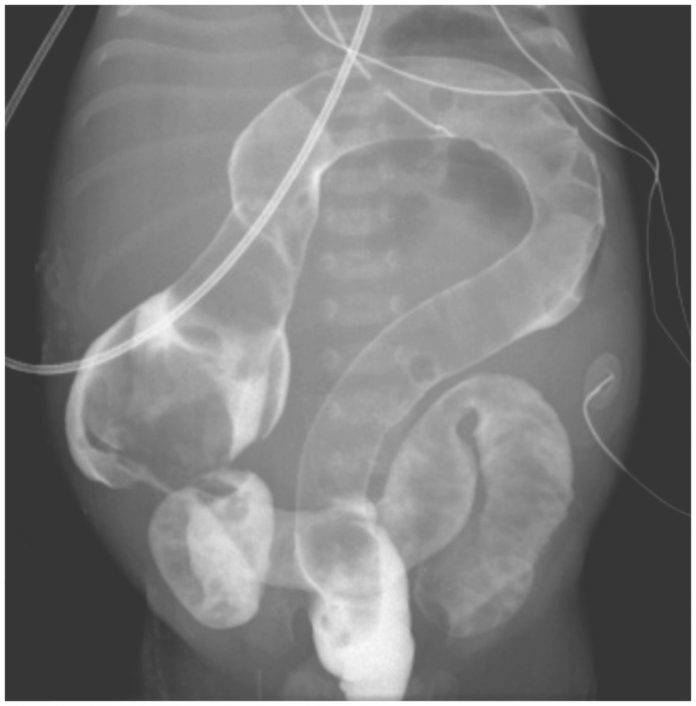A 28-year-old female gave birth to a baby boy born at 39 weeks of gestation. She presented as the baby had green-colored vomiting (bilious vomiting), failure to pass meconium, and abdominal distention within the first 24 hours of life.
An obstruction was suspected, so abdominal Xray was performed, which revealed dilated bowel, a finding consistent with distal obstruction. An enema with water-soluble contrast was performed, which revealed uniform distension and a short colon that had acquired ‘a question mark’ shape.
The findings were suggestive of total colonic aganglionosis.
A rectal biopsy was performed at the bedside using transanal suction to confirm the diagnosis. The biopsy sample showed no ganglion cells on hematoxylin and eosin staining, a negative result on calretinin staining, and abnormally thickened nerve fibers.
A diagnosis of Hirschsprung’s disease was made.
Laparoscopic serial frozen-section specimens were obtained from the entire colon in the operating room. Biopsy showed no ganglion cells, whereas the samples from the terminal ileum showed abundant ganglion cells. An end ileostomy was performed.
After 6 months, Duhamel procedure was performed (a colectomy with stapled side-to-side anastomosis of the terminal ileum to the rectal remnant. The surgery was successful, and the postoperative course was uneventful too. At subsequent follow-up visits, the infant was healthy, had achieved developmental milestones, and was having normal stool with 5 to 8 bowel movements daily.
Hirschsprung’s disease is a congenital disease characterized by the absence of enteric ganglion cells (nerve cells) in the bowel, which consequently result in a loss of bowel motility in affected areas. With no nerve cells in the bowel, the muscles of the bowel are unable to move. This results in obstruction of the bowel with stool.
Hirschsprung’s disease is responsible for 15-20% of the intestinal obstructions in the neonates. The most common presentation is the inability to pass meconium/stool in the first 48 hours of life accompanied by abdominal distension, and gradual onset of vomiting. The vomiting is bilious (contains bile).
The cause is still unknown; however, there may be a genetic predisposition. It is seen more commonly in males. An affected sibling increases the chances, and so do other congenital diseases, like Down’s syndrome.
A life-threatening complication of Hirschsprung’s disease is enterocolitis. Correct diagnosis and timely treatment are necessary to avoid complications.
References
Peter T. Masiakos, M. a. (2019, May 23). Question-Mark Appearance of the Colon. Retrieved from The New England Journal of Medicine: https://www.nejm.org/doi/full/10.1056/NEJMicm1811998




